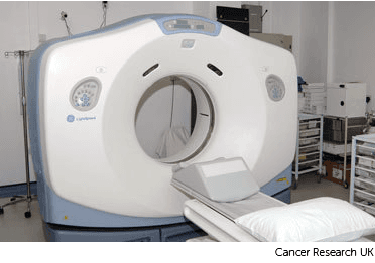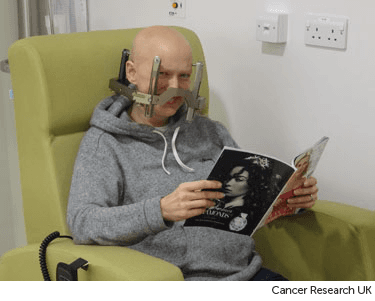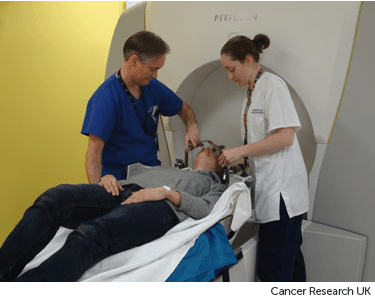Radiotherapy
The radiotherapy team plans your radiotherapy before you start treatment. This means working out the dose of radiotherapy you need and exactly where you need it. Your planning appointment takes from 15 minutes to 2 hours.
For a brain tumour, you usually have a planning CT scan and the radiotherapy team make a mask to keep your head still.
You usually have a planning CT scan in the radiotherapy department. The scan shows the cancer and the area around it. You might have other types of scans to help your treatment team plan your radiotherapy. The plan they create is just for you.

Your radiographers (sometimes called radiotherapists) tell you what is going to happen. They help you into position on the scan couch. You might have a type of firm cushion called a vacbag to help you keep still.
The CT scanner couch is the same type of bed that you lie on for your treatment sessions. You need to lie very still. Tell your radiographers if you aren't comfortable.
You might need an injection of contrast into a vein in your hand. This is a dye that helps body tissues show up more clearly on the scan.
Before you have the contrast, your radiographer asks you about any medical conditions or allergies. Some people are allergic to the contrast.
Once you are in position your radiographers move the couch up and through the scanner. They then leave the room and the scan starts.
The scan takes about 5 minutes. You won't feel anything. Your radiographers can see and hear you from the CT control area where they operate the scanner.
You need to keep your head still during radiotherapy. This is called immobilisation. You might have one of the following:
mask or mould
head frame
A radiotherapy mask is also called a shell. It keeps your head still each time you have your radiotherapy. So your treatment is as accurate as possible, and healthy tissues are not exposed to radiotherapy.
You can see through most types of masks, as they usually have lots of small holes. The radiographers might make marks on them. They use the marks to accurately line up the radiotherapy machine for each treatment.
Your team might make the mask in the mould room of the radiotherapy department or during your CT planning session. It takes between 10 to 45 minutes depending on the type of mask.
The mask is normally made directly against your skin. It's helpful to wear clothing that you can easily take off from around your neck. You also need to take off any jewellery from that area.
Having a lot of facial hair can make it difficult to make a head mask. The radiotherapy staff will tell you about any hair issues at your planning session.
A mould technician or radiographer uses a special kind of plastic that they heat in warm water. This makes it soft and pliable. They put the plastic on to your face so that it moulds exactly. It feels a little like a warm flannel and is a mesh with holes in so you can breathe.
After a few minutes the mesh gets hard. The technician takes the mask off and it is ready to use.
The mask is kept in the radiotherapy department and you wear it for each treatment. Or you might have a mask made for a single treatment.
The video below shows what happens when you have your mesh mask made. The video is about 1 and a half minutes long.
Your radiotherapy team might fit a head frame if you are going to have treatment from a GammaKnife machine. They usually fit the frame on the same day as your radiotherapy treatment.
They attach the head frame to your skull using 4 pins. Before they attach it, you have 4 injections of local anaesthetic at the points where the frame attaches to your head. This takes about 10 minutes. The head frame is then fixed into the radiotherapy machine while you are lying on the treatment couch.
As they fit the frame, you feel some pressure and tightness, but it usually feels better within a few minutes. You then have your radiotherapy treatment on the same day.


You usually have a head frame fitted for a single treatment or a small number of treatments. If you are going to have a number of treatments, you have the frame fitted and removed each time.
You might have to wait a few days or up to 3 weeks before you start treatment.
During this time the physicists and your radiotherapy doctor (clinical oncologist) decide the final details of your radiotherapy plan. They make sure that the area of the cancer will receive a high dose and nearby areas receive a low dose. This reduces the side effects you might get during and after treatment.
You usually have your radiotherapy as an outpatient. This means that you go to hospital every day, but you don't stay overnight. These visits can disrupt your day. So it’s worth sorting out a few things before you start treatment. These might include:
work
care for children or other loved ones
care for your pets
Find out what to happens during the radiotherapy appointments for a brain tumour
Last reviewed: 05 Apr 2023
Next review due: 05 Apr 2026
You have external radiotherapy in a hospital radiotherapy department. You usually have it as an outpatient each weekday over 3 to 6 weeks.
Stereotactic radiotherapy is a type of external radiotherapy. Some people may have a very high dose of stereotactic radiotherapy over one treatment. This is called radiosurgery.
Radiotherapy to the brain and spinal cord can cause side effects. These include tiredness and hair loss.
Practical and emotional support is available to help you cope with a brain or spinal cord tumour.
Primary brain tumours are tumours that start in the brain. They can start anywhere in the brain and there are many different types of tumour.
Primary brain tumours are cancers that start in the brain.

About Cancer generously supported by Dangoor Education since 2010. Learn more about Dangoor Education
What to ask your doctor about clinical trials.
Meet and chat to other cancer people affected by cancer.
Questions about cancer? Call freephone 0808 800 40 40 from 9 to 5 - Monday to Friday. Alternatively, you can email us.